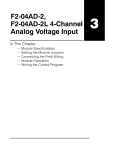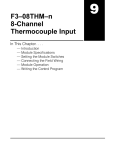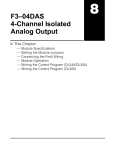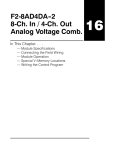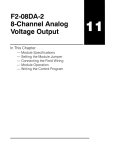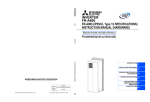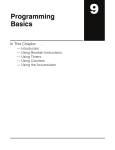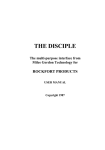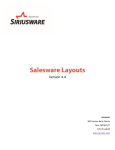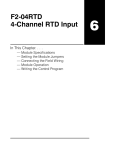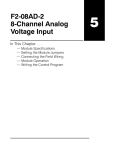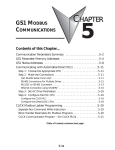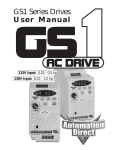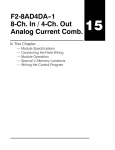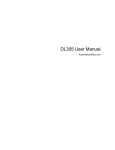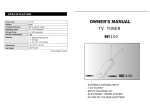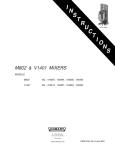Download F3–16AD 16-Channel Analog Input
Transcript
F3–16AD 16-Channel Analog Input In This Chapter. . . . Ċ Module Specifications Ċ Setting the Module Jumpers Ċ Connecting the Field Wiring Ċ Module Operation Ċ Writing the Control Program 15 5–2 F3–16AD 16-Channel Analog Input Module Specifications The following table provides the specifications for the F3–16AD Analog Input Module from FACTS Engineering. Review these specifications to make sure the module meets your application requirements. Number of Channels 16, single ended (one common) Input Ranges "5V, "10V, 0–5V1, 0–10V, 0–20 mA, 4 – 20 mA2 Resolution 12 bit (1 in 4096) Input Impedance 2MW, voltage input 500W "1%, current input Absolute Maximum Ratings "25V, voltage input "30 mA, current input Conversion Time Converter Type 35ms per channel 1 channel per CPU scan Successive Approximation, AD574 Linearity Error "1 count maximum Maximum Inaccuracy at 77 °F (25 °C) 0.25% of full scale, voltage input 1.25% of full scale, current input Accuracy vs. Temperature 57 ppm / _C maximum full scale Recommended Fuse 0.032 A, Series 217 fast-acting, current inputs Power Budget Requirement 33 mA @ 9 VDC, 47 mA @ 24 VDC External Power Supply None required Operating Temperature 32° to 140° F (0° to 60_ C) Storage Temperature –4° to 158° F (–20° to 70_ C) Relative Humidity 5 to 95% (non-condensing) Environmental air No corrosive gases permitted Vibration MIL STD 810C 514.2 Shock MIL STD 810C 516.2 Noise Immunity NEMA ICS3–304 F3–16AD 16-Channel Analog Input 1 – requires gain adjustment with potentiometer. 2 – resolution is 3275 counts (instead of 4096). Allows easier broken transmitter detection Analog Input Configuration Requirements The F3–16AD Analog Input appears as a 16-point module. The module can be installed in any slot configured for 16 points. See the DL305 User Manual for details on using 16 point modules in DL305 systems. The limitation on the number of analog modules are: S For local and expansion systems, the available power budget and 16-point module usage are the limiting factors. 5–3 F3–16AD 16-Channel Analog Input Setting the Module Jumpers Jumper Locations The module is set at the factory for a 0–20 mA signal on all sixteen channels. If this is acceptable you do not have to change any of the jumpers. The following diagram shows the jumper locations. ADJ Bipolar 10V Span Gain 20V X100 Gain X1 X1000 X10 Unipolar Polarity Current Channels 8 4 2 1 Selecting the Number of Channels If you examine the rear of the module, you’ll notice several jumpers. The jumpers labeled +1, +2, +4 and +8 are used to select the number of channels that will be used. Without any jumpers the module processes one channel. By installing the jumpers you can add channels. The module is set from the factory for sixteen channel operation. Any unused channels are not processed so if you only select channels 1–8, then the last eight channels will not be active. The following table shows which jumpers to install. +8 +4 +2 +1 Number of Channels Jumpers installed as shown selects 16-channel operation Jumper Channel(s) Jumper +4 +2 +1 +8 +4 +2 +1 1 No No No No 12 No No No Yes 123456789 Yes No No No 1 2 3 4 5 6 7 8 9 10 Yes No No Yes 123 No No Yes 1234 No No Yes No 1 2 3 4 5 6 7 8 9 10 11 Yes No Yes No Yes 1 2 3 4 5 6 7 8 9 10 11 12 Yes No Yes Yes 12345 No Yes No No 1 2 3 4 5 6 7 8 9 10 11 12 13 Yes Yes No No 123456 No 1234567 No Yes No Yes 1 2 3 4 5 6 7 8 9 10 11 12 13 14 Yes Yes No Yes Yes Yes No 1 2 3 4 5 6 7 8 9 10 11 12 13 14 15 Yes Yes Yes No 12345678 No Yes Yes Yes 1 2 3 4 5 6 7 8 9 10 11 12 13141516 Yes Yes Yes Yes F3–16AD 16-Channel Analog Input +8 Channel(s) 5–4 F3–16AD 16-Channel Analog Input Selecting Input Signal Ranges As you examined the jumper settings, you may have noticed there are current jumpers for each individual channel. These jumpers allow you to select the type of signal (voltage or current). The span and polarity jumpers are used to select the signal range. The polarity and span selection affect all the channels. For example, if you select unipolar operation and a 10V span, you can use both 0 –10V and 0–20 mA signals at the same time. Channels that will receive 0–20 mA signals should have the current jumper installed. The following table shows the jumper selections for the various ranges. (Only channel 1 is used in the example, but all channels must be set.) Bipolar Signal Range Jumper Settings Polarity –5 VDC to +5 VDC Bi Uni Current Jumper Span 20V 10V Gain Jumper x1 Polarity –10 VDC to +10 VDC Bi Uni x10 Current Jumper Span 20V 10V Gain Jumper x1 Unipolar Signal Range 0 to 20 mA (these settings are also used for the 4–20mA range) x10 Jumper Settings Polarity Bi Uni Current Jumper Span 20V 10V Gain Jumper x1 Polarity 0 VDC to +10 VDC Bi Uni Span 20V 10V x10 Current Jumper Gain Jumper x1 Polarity 0 VDC to +1 VDC Bi Uni x10 Current Jumper Span 20V 10V Gain Jumper x1 Polarity F3–16AD 16-Channel Analog Input 0 VDC to +0.1 VDC Bi Uni Span Current Jumper 20V 10V Gain Jumper x100 Polarity 0 VDC to +0.01 VDC Bi Uni x10 x1000 Current Jumper Span 20V 10V Gain Jumper x100 x1000 5–5 F3–16AD 16-Channel Analog Input Input Signal Range 0 VDC to +5 VDC (requires gain adjustment see instructions below) Jumper Settings Polarity Bi Uni Current Jumper Span 20V 10V Gain Jumper x1 0 VDC to +12 VDC (requires gain adjustment see instructions below) Polarity Bi Uni Span Current Jumper 20V 10V Gain Jumper x1 Variable Gain Adjustment If you look at the terminal block closely, you’ll notice a small hole conceals an adjustment potentiometer. This small potentiometer is used to adjust the gain for certain situations. For example, if you have 0–5V transmitters you have to use the 0–10V scale on the module. Since the module converts the signal to a digital value between 0 and 4095, a 5V signal would only yield a value of 2048. Fortunately, the variable gain feature provides a simple solution. Just complete the following steps. x10 x10 Potentiometer Adjustment Hole 1. Install a jumper on the gain adjustment pins. (This jumper location is labeled ADJ. This jumper will remain installed after the gain adjustment .) 2. Apply 5V to one of the channels. 3. Use a handheld programmer or DirectSOFT to monitor the input register that contains the analog data. (If you’re not familiar with this procedure, wait until you read the section on Writing the Control Program. This will show you how to get data into a register. You can come back to this procedure later.) 4. Adjust the potentiometer until the register value reads 4094 or 4095. The potentiometer is turned clockwise to increase the gain. F3–16AD 16-Channel Analog Input Now the module has been adjusted so a 5V signal provides a digital value of 4095 instead of 2048. 5–6 F3–16AD 16-Channel Analog Input Connecting the Field Wiring Wiring Guidelines Your company may have guidelines for wiring and cable installation. If so, you should check those before you begin the installation. Here are some general things to consider. S Use the shortest wiring route whenever possible. S Use shielded wiring and ground the shield at the signal source. Do not ground the shield at both the module and the source. S Don’t run the signal wiring next to large motors, high current switches, or transformers. This may cause noise problems. S Route the wiring through an approved cable housing to minimize the risk of accidental damage. Check local and national codes to choose the correct method for your application. F3–16AD 16-Channel Analog Input User Power Supply The F3–16AD receives all power from the base. A separate power supply is not required. Requirements 5–7 F3–16AD 16-Channel Analog Input Custom Input Ranges Occasionally you may have the need to connect a transmitter with an unusual signal range. By changing the wiring slightly and adding an external resistor to convert the current to voltage, you can easily adapt this module to meet the specifications for a transmitter that does not adhere to one of the standard input ranges. The following diagram shows how this works. Internal Module Circuitry + +CH1 50mA Current Transmitter - R= Jumper Removed R 250W COM Vmax Imax R = value of external resistor Vmax = high limit of selected voltage range Imax = maximum current supplied by the transmitter Example: current transmitter capable of 50mA, 0 - 10V range selected. R= 10V R = 200 ohms 50mA NOTE: Your choice of resistor can affect the accuracy of the module. A resistor that has "0.1% tolerance and a "50ppm / _C temperature coefficient is recommended. F3–16AD 16-Channel Analog Input 5–8 F3–16AD 16-Channel Analog Input Current Loop Transmitter Impedance Standard 4 to 20 mA transmitters and transducers can operate from a wide variety of power supplies. Not all transmitters are alike and the manufacturers often specify a minimum loop or load resistance that must be used with the transmitter at the various voltages. The F3–16AD provides 500 ohm resistance for each channel. If your transmitter requires a load resistance below 500 ohms, then you do not have to make any adjustments. However, if your transmitter requires a load resistance higher than 500 ohms, then you need to add a resistor in series with the module. Consider the following example for a transmitter being operated from a 36 VDC supply with a recommended load resistance of 750 ohms. Since the module has a 500 ohm resistor, you need to add an additional resistor. R + Tr * Mr R + 750 * 500 R w 250 R – Resistor to add Tr – Transmitter Requirement Mr – Module resistance (internal 500 ohms) DC Supply 0V +36V R + – F3–16AD 16-Channel Analog Input Two-wire Transmitter Module Channel 1 – 500W + 5–9 F3–16AD 16-Channel Analog Input Removable Connector The F3–16AD module has a removable connector to make wiring easier. Simply squeeze the top and bottom tabs and gently pull the connector from the module. Wiring Diagram Note 1: Terminate all shields at their respective signal source. Note 2: Jumpers for CH4, 7, 12 and 16 are installed for current input. See note CH1 Volatage Transmitter CH2 Volatage Transmitter CH3 Volatage Transmitter CH4 Current Transmitter CH5 Volatage Transmitter CH6 Volatage Transmitter CH8 Volatage Transmitter CH11 CH12 CH13 CH14 CH15 CH16 Internal Module Wiring ANALOG INPUT F3–16AD + + COM + Analog Switch 2 3 Current Transmitter CH10 + 1 CH7 CH9 + Volatage Transmitter Volatage Transmitter Volatage Transmitter Current Transmitter + 4 5 + 6 7 + 8 9 + 10 11 + 12 13 + 14 15 + 16 COM Volatage Transmitter Volatage Transmitter Volatage Transmitter Current Transmitter + + CH C O M 1 CH CH 2 3 CH CH 4 5 CH CH 6 7 CH CH 8 9 CH CH 10 11 CH CH 12 13 CH CH 14 15 C O M + CH 16 + All resistors are 500W F3–16AD 16-Channel Analog Input 5–10 F3–16AD 16-Channel Analog Input Module Operation Channel Scanning Sequence Before you begin writing the control program, it is important to take a few minutes to understand how the module processes and represents the analog signals. The F3–16AD module supplies 1 channel of data per each CPU scan. Since there are sixteen channels, it can take up to sixteen scans to get data for all channels. Once all channels have been scanned the process starts over with channel 1. You do not have to select all of the channels. Unused channels are not processed, so if you select only eight channels, then the channels will be updated within eight scans. Scan I/O Update Channel 1 Scan N Execute Application Program Channel 2 Scan N+1 Channel 16 Scan N+15 Channel 1 Scan N+16 F3–16AD 16-Channel Analog Input . . . Read the data . . . Store data Even though the channel updates to the CPU are synchronous with the CPU scan, the module asynchronously monitors the analog transmitter signal and converts the signal to a 12-bit binary representation. This enables the module to continuously provide accurate measurements without slowing down the discrete control logic in the RLL program. 5–11 F3–16AD 16-Channel Analog Input Understanding the You may recall the F3–16AD module appears to the CPU as a 16-point module. These 16 points provide: I/O Assignments S an indication of which channel is active. S the digital representation of the analog signal. Since all I/O points are automatically mapped into Register (R) memory, it is very easy to determine the location of the data word that will be assigned to the module. F3–16AD 8pt Relay 8pt Output 8pt Output 16pt Input 050 – 057 040 – 047 030 – 037 020 027 – 120 127 R 002, R012 16ch (Analog) 010 017 – 110 117 16pt Input 000 007 – 100 107 R 000, R010 R 011 MSB 1 1 7 R 001 LSB 1 1 0 MSB 0 1 7 LSB 0 1 0 Within these two register locations, the individual bits represent specific information about the analog signal. F3–16AD 16-Channel Analog Input 5–12 F3–16AD 16-Channel Analog Input F3–16AD 16-Channel Analog Input Active Channel Indicator Inputs The last four inputs of the upper Register indicate the active channel. The indicators automatically increment with each CPU scan. Channel Active Scan Inputs Channel N 0000 1 N+1 0001 2 N+2 0010 3 N+3 0011 4 N+4 0100 5 N+5 0101 6 N+6 0110 7 N+7 0111 8 N+8 1000 9 N+9 1001 10 N+10 1010 11 N+11 1011 12 N+12 1100 13 N+13 1101 14 N+14 1110 15 N+15 1111 16 R011 MSB LSB 1 1 1 1 1 1 1 1 1 1 1 1 1 1 1 1 7 6 5 4 3 2 1 0 - channel indicator inputs 5–13 F3–16AD 16-Channel Analog Input Analog Data Bits The remaining twelve bits represent the analog data in binary format. Bit Value Bit Value 0 (LSB) 1 6 64 1 2 7 128 2 4 8 256 3 8 9 512 4 16 10 1024 5 32 11 2048 R011 R001 MSB LSB 1 1 1 1 11 1 1 1 1 1 1 11 1 1 7 6 5 4 32 1 0 0 0 0 0 0 0 0 0 1 1 1 1 1 1 1 1 7 6 5 4 3 2 1 0 - data bits Since the module has 12-bit resolution, the analog signal is converted into 4096 “pieces” ranging from 0 – 4095 (212). For example, with a 0 to 10V scale, a 0V signal would be 0, and a 10V signal would be 4095. This is equivalent to a a binary value of 0000 0000 0000 to 1111 1111 1111, or 000 to FFF hexadecimal. The following diagram shows how this relates to each signal range. –10V – +10V –5V – +5V +V 0V – 10V 0 – 20mA +V 20mA 0V 0mA 4 – 20mA 20mA 0V -V 0 4095 0 4095 4mA 0 4095 0 819 4095 NOTE: When you use 4–20mA signals, you have to use the 0–20mA scale. You do not have resolution of 4096 if the 4–20mA signal is present. In this case, the range is 819 to 4095. This is because a 0 still represents 0mA, not 4mA. Each “piece” can also be expressed in terms of the signal level by using the equation shown. The following table shows the smallest signal levels that will possibly result in a change in the data value for each signal range. Range Resolution + H * L 4095 H = high limit of the signal range L = low limit of the signal range Lowest Signal Smallest Change –10 to +10V +10V –10V 4.88 mV –5 to +5V +5 V –5V 2.44 mV 0 to 5V 5V 0V 1.22 mV 0 to 10V 10V 0V 2.44 mV 0 to 12V 12V 0V 2.90 mV 20mA 0mA 4.88 mA 1V 0V 0.244 mV 0 to 0.1V 0.1 V 0V 24.4 uV 0 to 0.01V 0.01 V 0V 2.44 uV 0 to 20mA (4 to 20mA also) 0 to 1V F3–16AD 16-Channel Analog Input Highest Signal 5–14 F3–16AD 16-Channel Analog Input Writing the Control Program (DL330 / DL340) Identifying the Data Locations Since all channels are multiplexed into a single data word, the control program must be setup to determine which channel is being read. Since the module provides input points to the CPU, it is very easy to use the active channel status bits to determine which channel is being monitored. F3–16AD 8pt Relay 8pt Output 8pt Output 050 – 057 040 – 047 030 – 037 R 002, R012 16pt Input 020 027 – 120 127 16ch (Analog) 010 017 – 110 117 16pt Input 000 007 – 100 107 R 000, R010 R 011 MSB F3–16AD 16-Channel Analog Input 1 1 7 R 001 LSB 1 1 0 MSB 0 1 7 LSB 0 1 0 5–15 F3–16AD 16-Channel Analog Input Example Program The following example shows a program designed to read any of the available channels of analog data into Register locations. Once the data is in a Register, you can perform math on the data, compare the data against preset values, etc. Since the DL305 CPUs use 8-bit word instructions, you have to move the data in pieces. It’s pretty simple if you follow the example. Identify the channel 374 Read the data 374 DSTR2 R011 F52 This rung loads the channel ID bits into the accumulator from Register 011 on every scan. BCD F86 Convert the channel ID status to BCD. (We’ll use relational contacts later to make the chanel selection much easier.) DOUT R600 F60 Store the channel ID in R600. (Note, you don’t absolutely have to do it this way. If you use R600, then you can’t use Timer/Counter 600. You could just use the channel indicators. See the Store Channel 1 example that follows.) DSTR3 R011 F53 This rung loads the four least significant data bits into the accumulator from Register 011 on every scan. DOUT1 R501 F61 Temporarily store the bits to Register 501. DSTR1 R001 F51 This rung loads the eight least significant data bits into the accumulator from Register 001. DOUT1 R500 F61 Temporarily store the bits to Register 500. Since the most significant bits were loaded into 501, now R500 and R501 contain all twelve bits in order. DSTR R500 F50 Now that all the bits are stored, load all twelve bits into the accumulator. BCD F86 Store channel data Store channel 1 114 115 116 117 Store channel 2 CT600 K0001 = = Store channel 16 CT600 K0015 = F60 DOUT R402 F60 DOUT R434 F60 DOUT R436 F60 The channel selection inputs are used to let the CPU know which channel has been loaded into the accumulator. By using these inputs to control a DOUT instruction, you can easily move the data to a storage register. Notice the DOUT instruction stores the data in two bytes. (Two bytes are required for four digit BCD numbers.) This rung shows how you would use the channel indicator inputs as contacts to control the channel selection. This rung shows an easier way. Earlier we loaded the channel ID bits (in BCD format) into R600. Now we can use one relational contact to examine this value. However, this method uses the register associated with Timer/Counter 600. If you use this method, make sure you don’t use the Timer/Counter associated with the register elsewhere in the program. F3–16AD 16-Channel Analog Input Store channel 15 CT600 K0014 DOUT R400 Math operations are performed in BCD. This instruction converts the binary data to BCD. (You can omit this step if your application does not require the conversion.) 5–16 F3–16AD 16-Channel Analog Input Scaling the Input Data Most applications usually require measurements in engineering units, which provide more meaningful data. This is accomplished by using the conversion formula shown. The following example shows how you would use the analog data to represent pressure (PSI) from 0 to 100. This example assumes the analog value is 1760. This should yield approximately 42.9 PSI. Units + A S 4096 Units = value in Engineering Units A = Analog value (0 – 4095) S = high limit of the Engineering unit range Units + A S 4096 Units + 1760 100 4096 F3–16AD 16-Channel Analog Input Units + 42.9 5–17 F3–16AD 16-Channel Analog Input The following instructions are required to scale the data. (We’ll continue to use the 42.9 PSI example.) In this example we’re using channel 1. The active channel indicator inputs are all off when channel 1 data is being read. Of course, if you were using a different channel, you would use the active channel indicator point combination that corresponds to the channel you were using. This example assumes you have already read the analog data and stored the BCD equivalent in R400 and R401 Scale the data 114 115 116 117 DSTR R400 F50 This instruction brings the analog value (in BCD) into the accumulator. Accumulator Aux. Accumulator 1 7 6 0 0 0 0 0 R577 DIV K4096 F74 The analog value is divided by the resolution of the module, which is 4096. (1760 / 4096 = 0.4296) Accumulator Aux. Accumulator 0 0 0 0 4 2 9 6 R577 DSTR R576 F50 F73 F50 R576 The accumulator is then multiplied by the scaling factor, which is 100. (100 x 4296 = 429600). Notice the most significant digits are now stored in the auxilliary accumulator. (This is different from the way the Divide instruction operates.) 9 DSTR R576 R576 This instruction moves the two-byte decimal portion into the accumulator for further operations. Accumulator Aux. Accumulator 4 2 9 6 4 2 9 6 R577 MUL K100 R576 Accumulator 6 0 0 Aux. Accumulator 0 0 4 2 R577 R576 This instruction moves the two-byte auxilliary accumulator for further operations. Accumulator Aux. Accumulator 0 0 4 2 0 0 4 2 DOUT R450 F60 R577 R576 This instruction stores the accumulator to R450. R450 now contains the PSI, which is 42 PSI. Accumulator Store in R451 & R450 0 0 4 2 0 0 4 2 R450 F3–16AD 16-Channel Analog Input R451 5–18 F3–16AD 16-Channel Analog Input You probably noticed the previous example yielded 42 PSI when the real value should have been 42.9 PSI. By changing the scaling value slightly, we can “imply” an extra decimal of precision. Notice in the following example we’ve added another digit to the scale. Instead of a scale of 100, we’re using 1000, which implies 100.0 for the PSI range. This example assumes you have already read the analog data and stored the BCD equivalent in R400 and R401 Scale the data 114 115 116 117 DSTR R400 F50 This instruction brings the analog value (in BCD) into the accumulator. Accumulator Aux. Accumulator 1 7 6 0 0 0 0 0 R577 DIV K4096 F74 The analog value is divided by the resolution of the module, which is 4096. (1760 / 4096 = 0.4296) Accumulator Aux. Accumulator 0 0 0 0 4 2 9 6 R577 DSTR R576 F50 F73 F50 R576 The accumulator is multiplied by the scaling factor, which is now 1000. (1000 x 4296 = 4296000). The most significant digits are now stored in the auxilliary accumulator. (This is different from the way the Divide instruction operates.) 6 DSTR R576 R576 This instruction moves the two-byte decimal portion into the accumulator for further operations. Accumulator Aux. Accumulator 4 2 9 6 4 2 9 6 R577 MUL K1000 R576 Accumulator 0 0 0 Aux. Accumulator 0 4 2 9 R577 R576 This instruction moves the two-byte auxilliary accumulator for further operations. Accumulator Aux. Accumulator 0 4 2 9 0 4 2 9 DOUT R450 F60 R577 R576 F3–16AD 16-Channel Analog Input This instruction stores the accumulator to R450 and R451. R450 and R451 now contain the PSI, which implies 42.9. Accumulator Store in R451 & R450 0 4 2 9 0 4 2 9 R451 R450 5–19 F3–16AD 16-Channel Analog Input This example program shows how you can use the instructions to load these equation constants into data registers. The example is written for channel 1, but you can easily use a similar approach to use different scales for all channels if required. You may just use the appropriate constants in the instructions dedicated for each channel, but this method allows easier modifications. For example, you could easily use an operator interface or a programming device to change the constants if they are stored in Registers. Load the constants 374 Read the data 374 Store channel 1 114 115 116 117 On the first scan, these first two instructions load the analog resolution (constant of 4096) into R460 and R461. DSTR K4096 F50 DOUT R460 F60 DSTR K1000 F50 DOUT R462 F60 DSTR3 R011 F53 This rung loads the four most significant data bits into the accumulator from Register 011 on every scan. DOUT1 R501 F61 Temporarily store the bits to Register 501. DIV R460 F74 The analog value is divided by the resolution of the module, which is stored in R460. DSTR R576 F50 This instruction moves the decimal portion from the auxilliary accumulator into the regular accumulator for further operations. MUL R462 F73 The accumulator is multiplied by the scaling factor, which is stored in R462. DSTR R576 F50 This instruction moves most significant digits (now stored in the auxilliary accumulator) into the regular accumulator for further operations. DOUT R400 F60 The scaled value is stored in R400 and R401 for further use. These two instructions load the high limit of the Engineering unit scale (constant of 1000) into R462 and R463. Note, if you have different scales for each channel, you’ll also have to enter the Engineering unit high limit for those as well. F3–16AD 16-Channel Analog Input 5–20 F3–16AD 16-Channel Analog Input Broken Transmitter If you use 4–20mA signals you can easily check for broken transmitter conditions. Since you have to use the 0–20mA range and the lowest signal for the 4–20mA Detection transmitter is 4mA, the lowest digital value for the signal is not 0, but instead is 819. If the transmitter is working properly the smallest value you should ever see is 819. If you see a value of less than about 750 (allowing for tolerance), then you know the transmitter is broken. Read the channel ID 374 Read the data 374 Store channel 1 114 115 116 117 DSTR2 R011 F52 This rung loads the channel ID bits into the accumulator from Register 011 on every scan. BCD F86 Convert the channel ID status to BCD. We’ll use relational contacts later to make the chanel selection much easier.) DOUT R600 F60 Store the channel ID in R600. DSTR3 R011 F53 This rung loads the four most significant data bits into the accumulator from Register 011 on every scan. DOUT1 R501 F61 Temporarily store the bits to Register 501. DSTR1 R001 F51 This rung loads the eight least significant data bits into the accumulator from Register 001. DOUT1 R500 F61 Temporarily store the bits to Register 500. Since the most significant bits were loaded into 501, now R500 and R501 contain all twelve bits in order. DSTR R500 F50 Now that all the bits are stored, load all twelve bits into the accumulator. BCD F86 DOUT R400 F60 CMP K0100 F70 F3–16AD 16-Channel Analog Input Broken transmitter indicator on channel 1 773 114 115 116 117 040 OUT 774 Math operations are performed in BCD. This instruction converts the binary data to BCD. (You can omit this step if your application does not require the conversion.) The DOUT instruction copies the accumulator data to R400 and R401. Since the data is still in the accumulator, we can compare it against a constant. Since the minimum value for a 4mA signal is 819 (minus the module tolerance), we can choose a value for the compare. We picked 100, but you could choose something else from 0 to about 750. Flags 773 and 774 are used with the Compare instruction. In this example if the analog value is less than or equal to 100, then output 040 is turned on. You may want to latch 040 to catch intermittent broken transmitters. 5–21 F3–16AD 16-Channel Analog Input Writing the Control Program (DL350) Reading Values: Pointer Method and Multiplexing There are two methods of reading values for the DL350: S The pointer method (all system bases must be D3–xx–1 bases to support the pointer method) S Multiplexing You must use the multiplexing method with remote I/O modules (the pointer method will not work). You can use either method when using DL350, but for ease of programming it is strongly recommended that you use the pointer method. NOTE: Do not use the pointer method and the PID PV auto transfer from I/O module function together for the same module. If using PID loops, use the pointer method and ladder logic code to map the analog input data into the PID loop table. Pointer Method The DL350 has special V-memory locations assigned to each base slot that greatly simplifies the programming requirements. These V-memory locations allow you to: S specify the data format S specify the number of channels to scan S specify the storage locations The example program shows how to setup these locations. Place this rung anywhere in the ladder program or in the Initial Stage if you are using RLL PLUS instructions. This is all that is required to read the data into V-memory locations. Once the data is in V-memory, you can perform math on the data, compare the data against preset values, and so forth. V2000 is used in the example, but you can use any user V-memory location. In this example the module is installed in slot 2. You should use the V-memory locations for your module placement. 16 channels selected 15 channels selected SP0 LD K 1000 - or - LD K 9 000 LD K 0f 00 - or - LD K 8f 00 Loads a constant that specifies the number of channels to scan and the data format. For 1–15 channels, the upper byte, most significant nibble (MSN) selects the data format (i.e. 0=BCD, 8=Binary), the LSN selects the number of channels (i.e. 1, 2, 3, 4, 5, 6, 7, 8, 9, a, b, c, d, e, f). To select 16 channels, the upper nibble (MSN) selects the data format and the number of channels (i.e. 1=16 channels BCD, 9= 16 channels Binary). LDA O2000 OUT V7672 Special V-memory location assigned to slot 2 that contains the number of channels to scan. This loads an octal value for the first V-memory location that will be used to store the incoming data. For example, the O2000 entered here would designate the following addresses. Ch1 - V2000, Ch2 - V2001, Ch3 - V2002, Ch4 - V2003, Ch5 – V2004, Ch6 – V2005, Ch7 – V2006, Ch8 – V2007, Ch9 – V2010, Ch10 – V2011, Ch11 – V2012, Ch12 – V2013 Ch13 – V2014, Ch14 – V2015, Ch15 – V2016, Ch16 – V2017 The octal address (O2000) is stored here. V7672 is assigned to slot 2 and acts as a pointer, which means the CPU will use the octal value in this location to determine exactly where to store the incoming data. F3–16AD 16-Channel Analog Input OUT V7662 5–22 F3–16AD 16-Channel Analog Input The table shows the special V-memory locations used with the DL350. Slot 0 (zero) is the module next to the CPU, slot 1 is the module two places from the CPU, and so on. Remember, the CPU only examines the pointer values at these locations after a mode transition. The pointer method is supported on expansion bases up to a total of 8 slots away from the DL350 CPU. The pointer method is not supported in slot 8 of a 10 slot base. Analog Input Module Slot-Dependent V-memory Locations F3–16AD 16-Channel Analog Input Slot 0 1 2 3 4 5 6 7 No. of Channels V7660 V7661 V7662 V7663 V7664 V7665 V7666 V7667 Storage Pointer V7670 V7671 V7672 V7673 V7674 V7675 V7676 V7677 5–23 F3–16AD 16-Channel Analog Input Multiplexing: DL350 with a Conventional DL305 Base The example below shows how to read multiple channels on an F3–08AD Analog module in the 20–27/120–127 address slot. This module must be placed in a 16 bit slot in order to work. Load the data _On SP1 LDF SHFL ORF X120 K8 This rung loads the upper byte of analog data from the module. K8 SHFL K8 shifts the data to the left eight places to make room for the lower byte of data. X20 K8 ANDD Kfff The ANDD Kfff masks off the four most significant bits of data from the word. This leaves the actual analog value. The BCD command converts the data to BCD format. BCD OUT The ORF X20 brings the lower byte of data from the module into the accumulator. At this time there is a full word of data from the analog module in the accumulator. Stores the data in V2200. V2200 Channel 1 Select Bit States X124 X125 X126 X127 LD V2200 OUT This sends channel one analog data to V3000 when bits X124, X125, X126 and X127 are as shown. V3000 Channel 2 Select Bit States X124 X125 X126 X127 LD V2200 OUT This sends channel two analog data to V3001 when bits X124, X125, X126 and X127 are as shown. V3001 X124 X125 X126 X127 LD V2200 OUT V3002 This sends channel two analog data to V3002 when bits X124, X125, X126 and X127 are as shown. F3–16AD 16-Channel Analog Input Channel 3 Select Bit States 5–24 F3–16AD 16-Channel Analog Input Multiplexing: DL350 with a D3–XX–1 Base The example below shows how to read multiple channels on an F3–16AD Analog module in the X0 address slot of the D3–XX–1 base. If any expansion bases are used in the system, they must all be D3–xx–1 to be able to use this example. Otherwise, the conventional base addressing must be used. _On SP1 LD VX0 This rung loads the upper byte of analog data from the module. K12 SHFL K12 shifts the word to the right twelve places. SHFR OUT _On SP1 LDF V1400 Puts the four channel select bits in the lower nibble (four bits) of word V1400. This will increment once with each scan from 0 to F. X0 This rung loads the twelve bits of analog data to the module and converts it to BCD. It is the OUT to V1401. K12 BCD OUT This converts the data to BCD. V1401 The analog data (in BCD format) is then stored in the Holding Register, V1401. Rungs 3–18 compare the count of the chennel select bits. When the corresponding bits are true, the channel data for that channel is stored in the proper V-memory location. For sixteen channels of analog data, the module will require sixteen scans in order to update all channels. Channel Selection Data V1400 K0 = LD V1401 Channel #1 Data OUT Channel Selection Data V1400 K1 = LD V2000 V1401 Channel #2 Data F3–16AD 16-Channel Analog Input OUT Channel Selection Data V1400 K2 = LD V2001 V1401 Channel #3 Data OUT V2002 5–25 F3–16AD 16-Channel Analog Input Channel Selection Data V1400 K3 = LD OUT Channel Selection Data V1400 K4 = LD V1401 Channel #4 Data V2003 V1401 Channel #5 Data OUT Channel Selection Data K5 V1400 = LD V2004 V1401 Channel #6 Data OUT Channel Selection Data V1400 K6 = LD V2005 V1401 Channel #7 Data OUT Channel Selection Data K7 V1400 = LD V2006 V1401 Channel #8 Data OUT Channel Selection Data K8 V1400 = LD V2007 V1401 Channel #9 Data Channel Selection Data K9 V1400 = LD V2010 V1401 Channel #10 Data OUT V2011 F3–16AD 16-Channel Analog Input OUT 5–26 F3–16AD 16-Channel Analog Input Channel Selection Data Ka V1400 = LD V1401 Channel #11 Data OUT Channel Selection Data Kb V1400 = LD V2012 V1401 Channel #12 Data OUT Channel Selection Data V1400 Kc = LD V2013 V1401 Channel #13 Data OUT Channel Selection Data Kd V1400 = LD V2014 V1401 Channel #14 Data OUT Channel Selection Data Ke V1400 = LD V2015 V1401 Channel #15 Data OUT Channel Selection Data Kf V1400 = LD V2016 V1401 F3–16AD 16-Channel Analog Input Channel #16 Data OUT V2017 5–27 F3–16AD 16-Channel Analog Input Scaling the Input Data Most applications usually require measurements in engineering units, which provide more meaningful data. This is accomplished by using the conversion formula shown. You may have to make adjustments to the formula depending on the scale you choose for the engineering units. Units + A H * L 4095 H = high limit of the engineering unit range L = low limit of the engineering unit range A = Analog value (0 – 4095) For example, if you wanted to measure pressure (PSI) from 0.0 to 99.9 then you would have to multiply the analog value by 10 in order to imply a decimal place when you view the value with the programming software or a handheld programmer. Notice how the calculations differ when you use the multiplier. Here is how you would write the program to perform the engineering unit conversion. This example assumes you have BCD data loaded into the appropriate V-memory locations using instructions that apply for the model of CPU you are using. NOTE: This example uses SP1, which is always on. You could also use an X, C, etc. permissive contact. SP1 LD V3000 When SP1 is on, load channel 1 data to the accumulator. MUL K1000 Multiply the accumulator by 1000 (to start the conversion). DIV K4095 Divide the accumulator by 4095. OUT V3020 Store the result in V3020. F3–16AD 16-Channel Analog Input 5–28 F3–16AD 16-Channel Analog Input Analog and Digital Sometimes it is helpful to be able to quickly convert between the signal levels and the Value Conversions digital values. This is especially helpful during machine startup or troubleshooting. The following table provides formulas to make this conversion easier. Range If you know the digital value ... If you know the analog signal level ... –10V to + 10V A + 20D * 10 4095 D + 4095 (A ) 10) 20 –5V to + 5V A + 10D * 5 4095 D + 4095 (A ) 5) 10 0 to 5V A + 5D 4095 D + 4095 A 5 0 to 10V A + 10D 4095 D + 4095 A 10 0 to 12V A + 12D 4095 D + 4095 A 12 0 to 20mA (or 4–20mA) A + 20D 4095 D + 4095 A 20 0 to 1V A + 1D 4095 D + 4095 A 1 0 to 0.1V A + 0.1D 4095 D + 4095 A 0.1 0 to 0.01V ȏA + 0.01D 4095 D + 4095 A 0.01 For example, if you are using the –10 to +10V range and you have measured the signal at 6V, you would use the following formula to determine the digital value that should be stored in the register location that contains the data. D + 4095 (A ) 10) 20 D + 4095 (6V ) 10) 20 D + (204.75) (16) F3–16AD 16-Channel Analog Input D + 3276




























